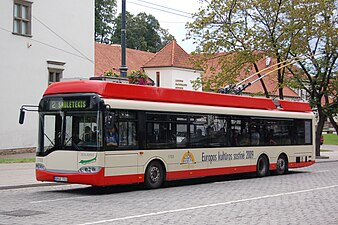You can help expand this article with text translated from the corresponding article in Polish. (November 2021) Click for important translation instructions.
|
| Solaris Trollino | |
|---|---|
 Solaris Trollino 12 4th generation in Vilnius Solaris Trollino 12 4th generation in Vilnius | |
| Overview | |
| Manufacturer | Solaris Bus & Coach |
| Also called | Škoda 26Tr, Škoda 27Tr, Škoda 28Tr, Škoda-Solaris 24M |
| Production | 2002-present |
| Assembly | Bolechowo-Osiedle, Poland |
| Body and chassis | |
| Class | Single-deck trolleybus |
| Doors | 2-5 doors |
| Floor type | Low floor |
| Powertrain | |
| Power output | 160–320 kW (214.6–429.1 hp) |
| Dimensions | |
| Length | 12,000–18,750 mm (472.4–738.2 in) |
| Width | 2,550 mm (100.4 in) |
| Height | 3,450 mm (135.8 in) |
| Curb weight | 11,400–18,500 kg (25,132.7–40,785.5 lb) |
Solaris Trollino is a series of low-floor trolleybuses designed for public transport, produced since 1999 by the Polish company Solaris Bus & Coach. The power regulation electronics and traction motors are delivered by other companies, such as Škoda Electric, Kiepe Electric, Medcom [pl] or Cegelec.
The first prototype was produced in 2001 and ran the first races on the Gdynia road network.
Description and models
There are four different length variants (the number indicates length in meters):
- Solaris Trollino 12 (also sold as Škoda 26Tr Solaris)
- Solaris Trollino 15 (also sold as Škoda 28Tr Solaris) - no longer in production
- Solaris Trollino 18 (articulated, also sold as Škoda 27Tr Solaris)
- Solaris Trollino 24 (bi-articulated, also sold as Škoda-Solaris 24M)
| Type | Number manufactured | Powertrain options |
|---|---|---|
| Solaris Trollino 12 / Škoda 26Tr Solaris | 182 / 302 | Škoda 160 kW, Kiepe 160 kW, MEDCOM 175 kW |
| Solaris Trollino 15 / Škoda 28Tr Solaris | 49 / 35 | Škoda 250 kW |
| Solaris Trollino 18 / Škoda 27Tr Solaris | 114 / 260 | Škoda 250 kW, Kiepe 2x160 kW, MEDCOM 250 kW |
| Solaris Trollino 24 / Škoda-Solaris 24M | 1 / 36 | Kiepe 2x160 kW |
The trolleybuses can be fully dependent on wires, or they can be equipped with supercapacitors, batteries, fuel cells or diesel generators.
-
 Solaris Trollino 12 3rd generation in Tychy
Solaris Trollino 12 3rd generation in Tychy
-
 Solaris Trollino 15 1st generation in Vilnius
Solaris Trollino 15 1st generation in Vilnius
-
 Solaris Trollino 18 3rd generation in Riga
Solaris Trollino 18 3rd generation in Riga
-
 Solaris Trollino 24 prototype
Solaris Trollino 24 prototype
References
- ^ "Trollino". www.solarisbus.com (in English and Polish). Retrieved 2017-12-16.
- "History". www.solarisbus.com (in English and Polish). Retrieved 2017-12-16.
- ^ Šplíchal, Jiří (2021). 85 let výroby trolejbusů Škoda (in Czech). Plzeň: SPVD. p. 326. ISBN 978-80-270-9960-3.